With diverse neighborhoods, countless historical sights, viewpoints and beautiful streets to get lost in, discovering the best things to do in Lisbon can be a little overwhelming. So, after visiting the city no less than 4 times, I’ve curated my absolute favourites into this guide.
I still remember the first time I set foot in Lisbon. To say that is was love at first sight is an understatement. I am the type of person who knows instantly if I will like a place or not based on the vibes it gives. And Lisbon was had that vibes…
How would I describe it? It has the relax atmosphere of the Mediterranean without feeling sleepy; it is historical without feeling stuffy, everything is a little bit hipster, it’s young, and it doesn’t pretend to be something that it’s not. I’ve read how some people found it “dirty” because it had graffitis on buildings and trams, but I couldn’t disagree more. That’s part of the Lisbon charm, that’s part of what makes it unique and beautiful.
Lisbon is also not what you think of when you think “European capital”. It is not as grandiose as Paris or Rome; it does not have an Eiffel Tower or a Coliseum. Despite being the second oldest capital in Europe (after Athens), Lisbon does not seem old. And there is a reason for that: it had to be rebuilt almost completely after the 1755 earthquake. It that sense, the Lisbon you see today is relatively young compared to it’s European counterparts.
Lisbon also often feels many small towns rather than one large capital city. Each one of it’s neighbourhood has a character of it’s own and each deserves to be explored!
And the food, the food! In all honestly, I feel like the food in Portugal rivals that of France or Italy (it might even be better…). Portuguese cuisine is simple and fresh : salt, olive oil and garlic are the main seasoning. But it’s that freshness that gets me every time! A trip to Lisbon will definitely please all the foodies out there!
Alongside personal favourites and tips, I’ve shared the best things to do in Lisbon in this blog post to help you know exactly where to go and what to do on your own visit.
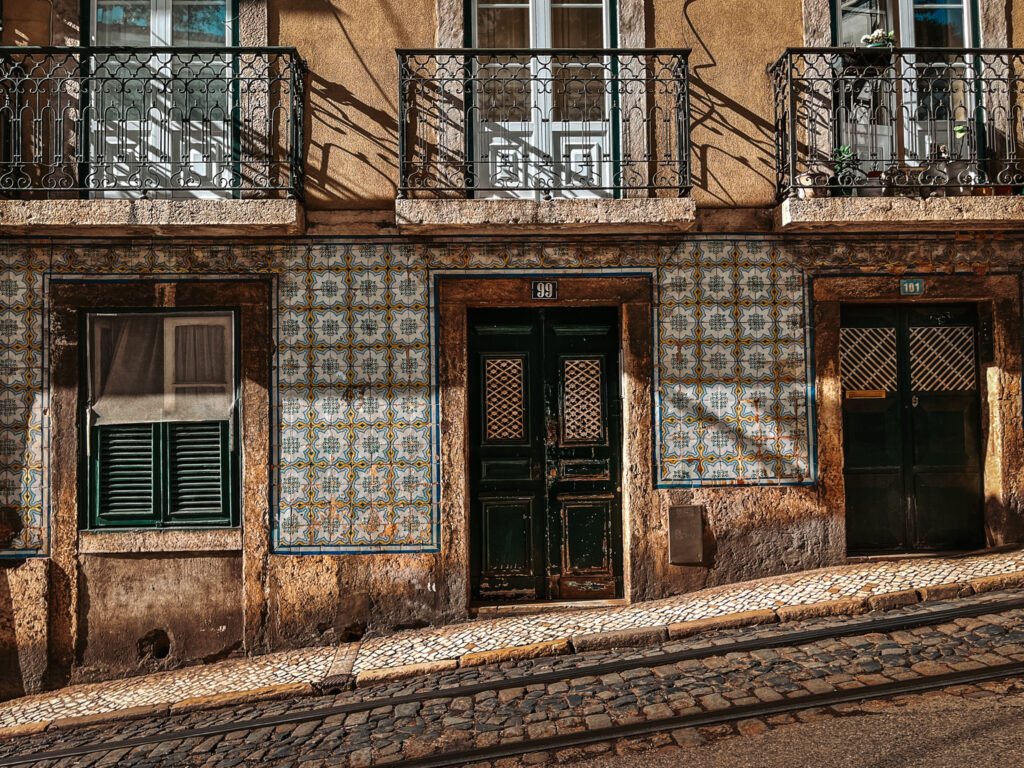
11 AMAZING THINGS TO DO IN LISBON
DISCOVER ALFAMA, LISBON’S OLDEST DISTRICT
I might be biased, but everytime I visit Lisbon, Alfama is where I start my visit.
Alfama, Lisbon’s oldest neighborhood, is by far my favorite! What sets it apart is its remarkable history: it miraculously escaped the devastating earthquake of 1755 that ravaged much of central Lisbon.
What happened in 1755 exactly?
The Great Lisbon earthquake, often referred to as the 1755 Lisbon earthquake, had a significant impact on Portugal, the Iberian Peninsula, and Northwest Africa.
It struck on the morning of Saturday, 1 November, coinciding with the Feast of All Saints, at approximately 09:40 local time. This earthquake, along with subsequent fires and a devastating tsunami, resulted in extensive destruction throughout Lisbon and its surrounding areas.
It is estimated that the death toll in Lisbon alone reached around 12,000, making it one of the most destructive earthquakes in history. Furthermore, this seismic event had far-reaching consequences as it heightened political tensions within Portugal and severely disrupted the Portuguese Empire.
Strolling through Alfama today therefore offers an enchanting glimpse into the past and showcases a blend of architectural styles that have stood the test of time.
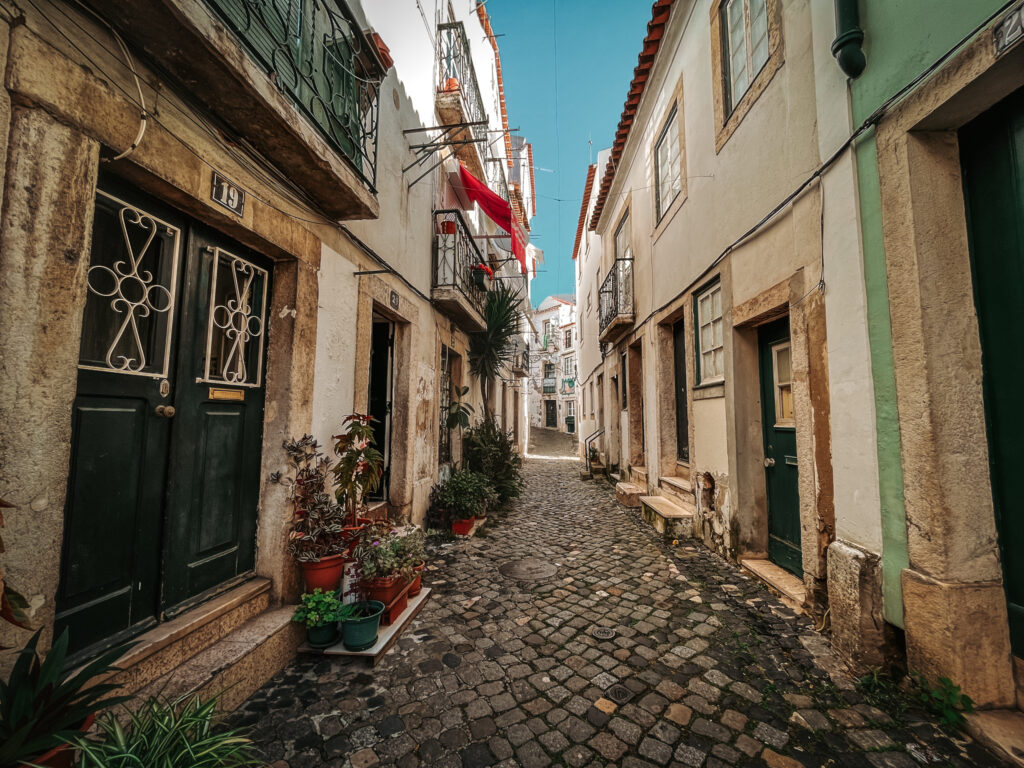
How to Get There | Although trams 12 and 28 (which follow the same route) cover parts of Alfama, the best way to visit is on foot. It is worth nothing however that visiting Alfama means a lot (I mean a lot!) of stairs.
This isn’t a hidden gem, and will draw large crowds of locals and travellers, especially during peak season in the summer. Going early in the morning is your best chance at enjoying the peace and quiet of this neighborhood. Plus you’ll get to see it come alive and feel like a local!
Foodie break // Whether you are hungry for a snack or for a bigger meal, here are my recommendations:
Pastelaria Alfama Doce | I found this place randomly on my second visit to Lisbon. Of course I had to try their Pastéis da Nata and they easily ranked in the top 3 I’ve had in Lisbon.
Aflama Cellar | This place was highly recommended to me by a colleague and it did not disappoint. This is a tiny hole in the wall restaurant so be sure not to miss it when you are walking by. Try their Grandmother Stew, a delicious cod fish stew with clams.
Travel Tip // Alfama can be accessed either from the lower part (next to the water) or from the higher part (starting at Largo da Graça). But to reduce the amount of climbing I suggest taking tram 12 or 28 to Lg. Portas Sol and take the stairs down to Alfama from there.
If you prefer not to get lost, then I recommend joining a walking tour:
This Free Walking Tour brings you on a 3-hour walk through all the key neighborhoods in Lisbon. I’ve done it twice and found it extremely informative and fun: the tour ends in Alfama. (Don’t forget to tip your guide at the end of the tour.)
If you want a tour focus solely on Alfama, this Walking Tour is a good alternative option, with fantastic reviews across the board.
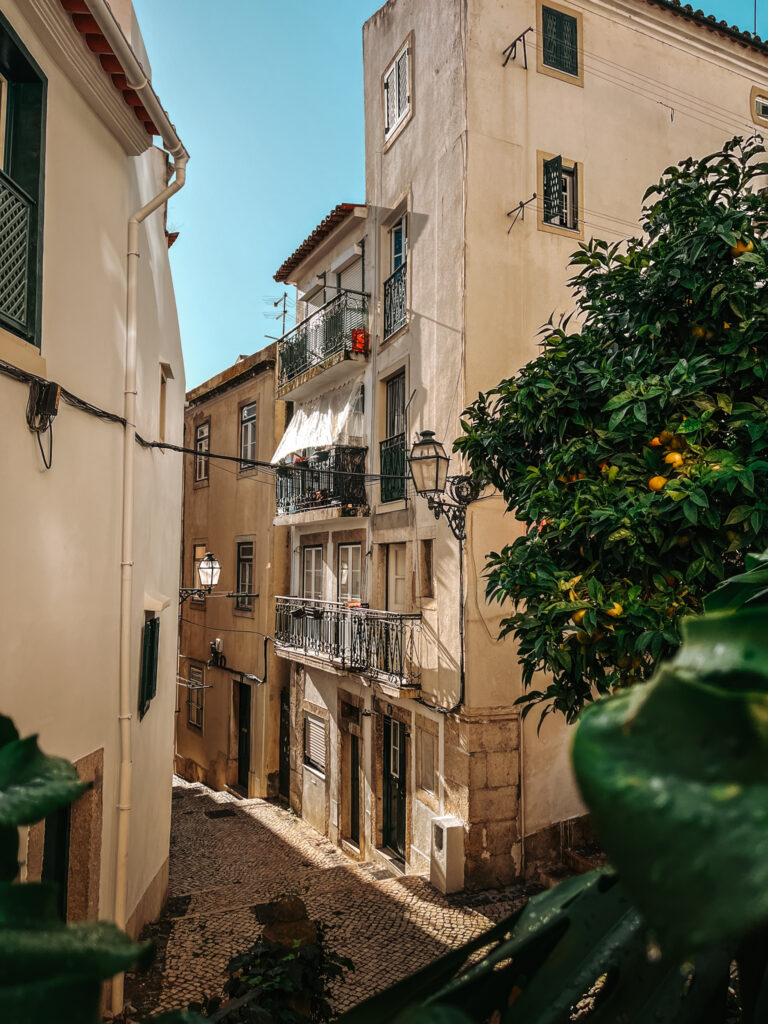
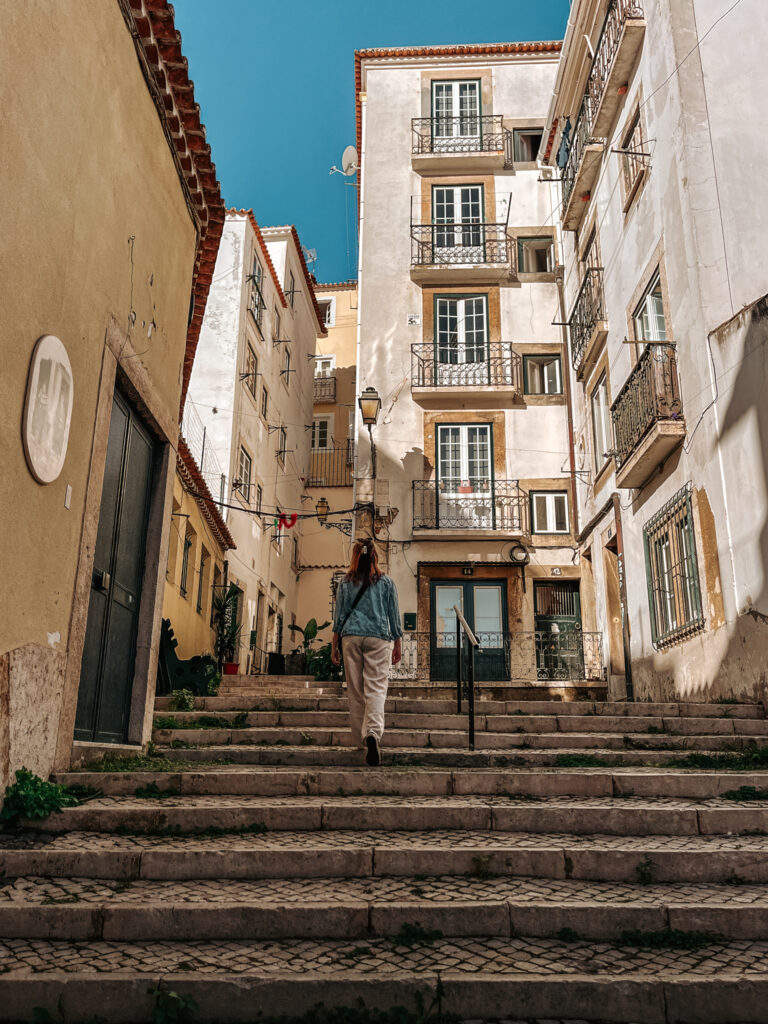
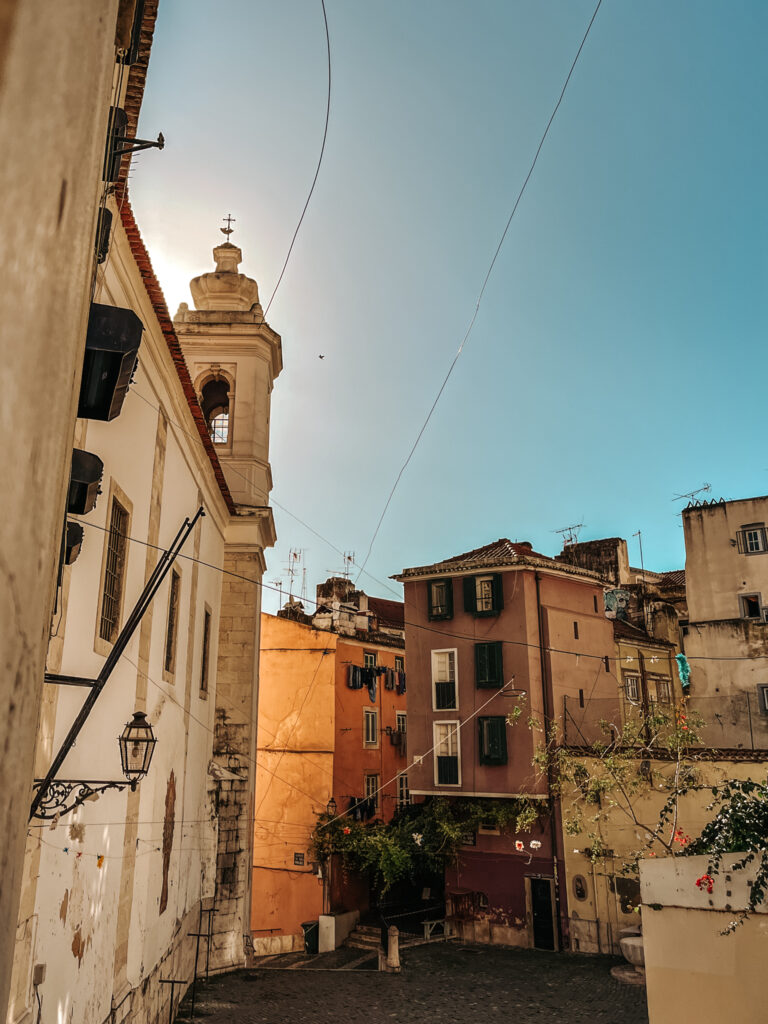
ENJOY THE VIEW FROM ONE OF THE MANY MIRADOUROS
According to the legends, Lisbon was founded out of a love story (or a heartbreak one to be more precise). It goes something like this: In Greek mythology, the land that is now Portugal was ruled by a Queen who was half woman, half serpent.
When ancient Greek hero Odysseus (or Ulysses for the Romans) arrived on her land, she immediately fell in love with him. The Queen did everything in her power to keep Odysseus with her. Unfortunately for her, his heart belonged to his wife Penelope who waited for him in Greece.
When he left, the Queen is said to have been so angry that her armed turned into serpents and formed the seven hills of Lisbon. Thus giving it the nickname of the “City of the Seven Hills”.
In reality however, it is more likely that the nickname comes from the 17th century book Livro Das Grandezas De Lisboa which mentions “a city located on seven hills…”.
Whether you like the romantic version or the more pragmatic one, the lesson to take away it that Lisbon has many hills! That means you’ll be climbing for most of your visit, but it also means that you’ll get some amazing lookouts throughout the city: these are called Miradouros.
Miradouros are basically balconies or gardens allowing panoramic views of the surroundings. In Portugal, these beautiful terraces were built for the purpose of letting people sit, rest and take in the views.
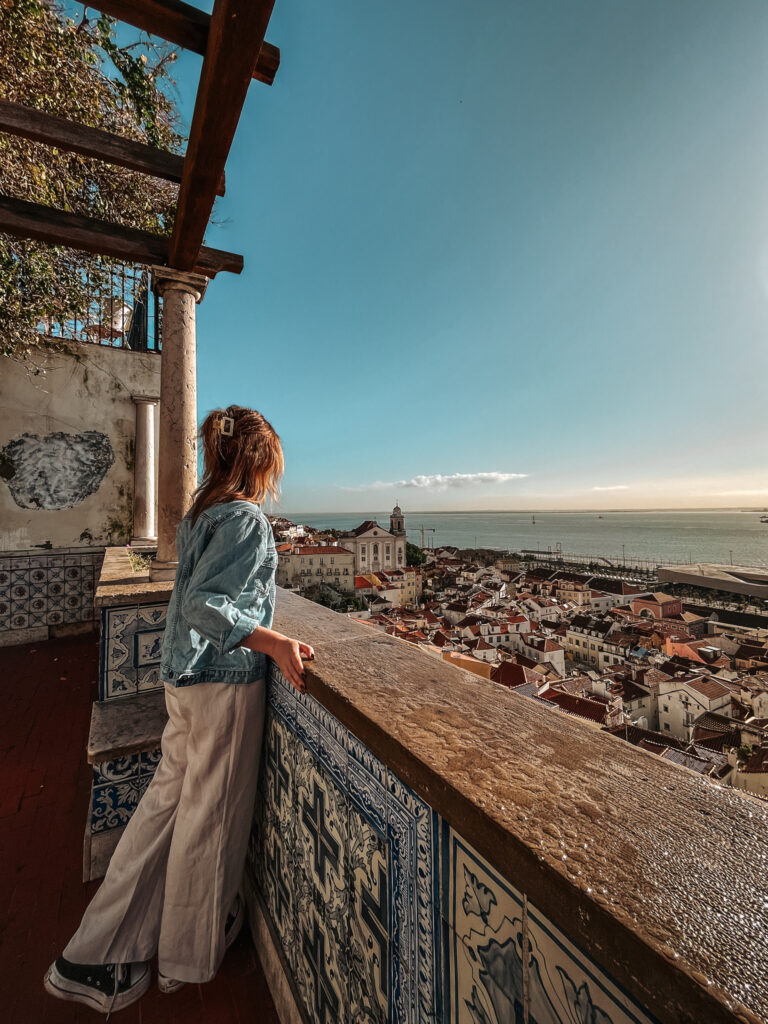
Here are some of the most scenic Miradouros in Lisbon :
Miradouro da Santa Luzia | This is my favorite Miradouro and certainly the most Instagram worthy! What makes it unique is that it’s located inside a small garden surrounded by beautiful Azulejo tiles. This one is extremely popular so get there early if you want your picture perfect moment.
Miradouro das Portas do Sol | Not far from Santa Luzia, Miradouro das Portas do Sol offers a stunning views over the Alfama district.
Miradouro da Graça | Located next to Graça Church this Miradouro is definitely a local favorite. This is the perfect spot to sip wine while watching the sunset.
Miradouro de São Pedro de Alcántara | One the opposite hill, in Barrio Alto, you’ll find Miradouro de São Pedro de Alcântara. With it’s fountain and curated gardens, this Miradouro offers amazing views on the São Jorge Castle.
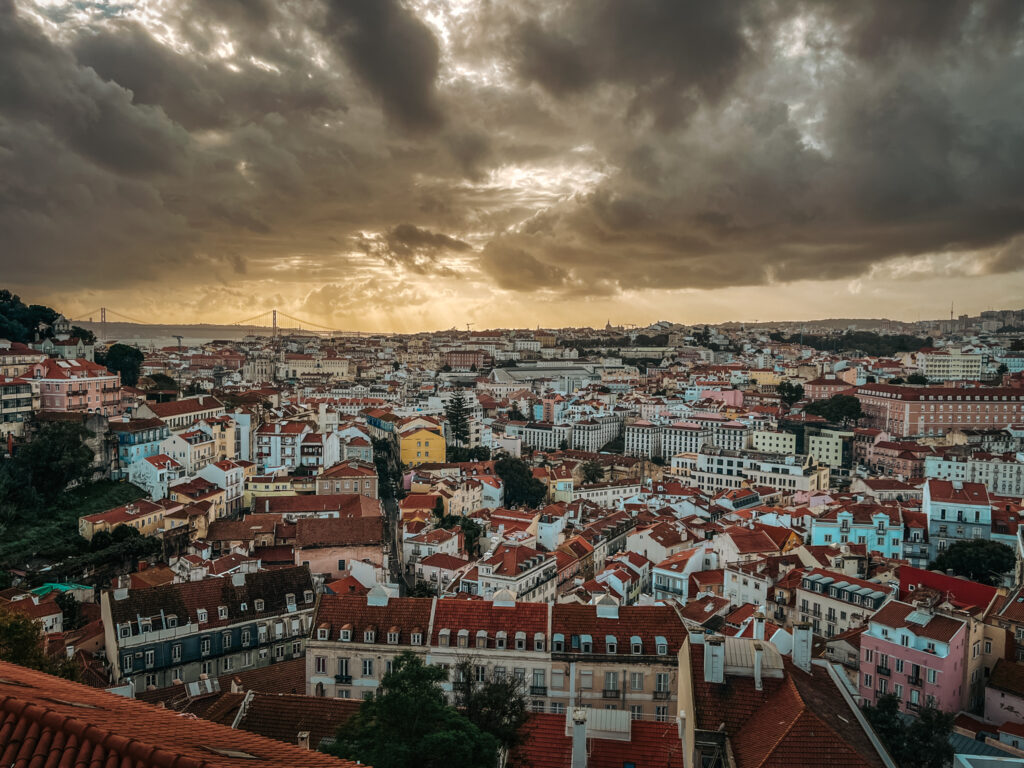
TAKE A STROLL THROUGH PRAÇA DO COMÉRCIO AND THE BAXIA DISTRICT
Completely rebuild after the 1755 earthquake, the Baxia district couldn’t be more different then the Aflama district. Here, the perfectly organized street are a striking contrast from Alfama’s narrow alleyways.
We owe this reconstruction to the Marquis of Pombal, who after the Great Earthquake of 1755, was nicknamed the “savior of Lisbon”. Not only did he organize relief for survivors and burry the dead, but he also led the reconstruction of the city. In less than a year, the Baxia district had risen from it’s ashes.
In the neoclassical style of the time, he planned for large geometric streets. This was the first great example of neoclassical design in Europe and one of the finest European architectural achievements of the age.
Built on the flattest part of Lisbon (your legs will enjoy this much deserved break from hills!) this district is a testimony of Lisbon’s desire to modernize in the wake of the 1755 earthquake.
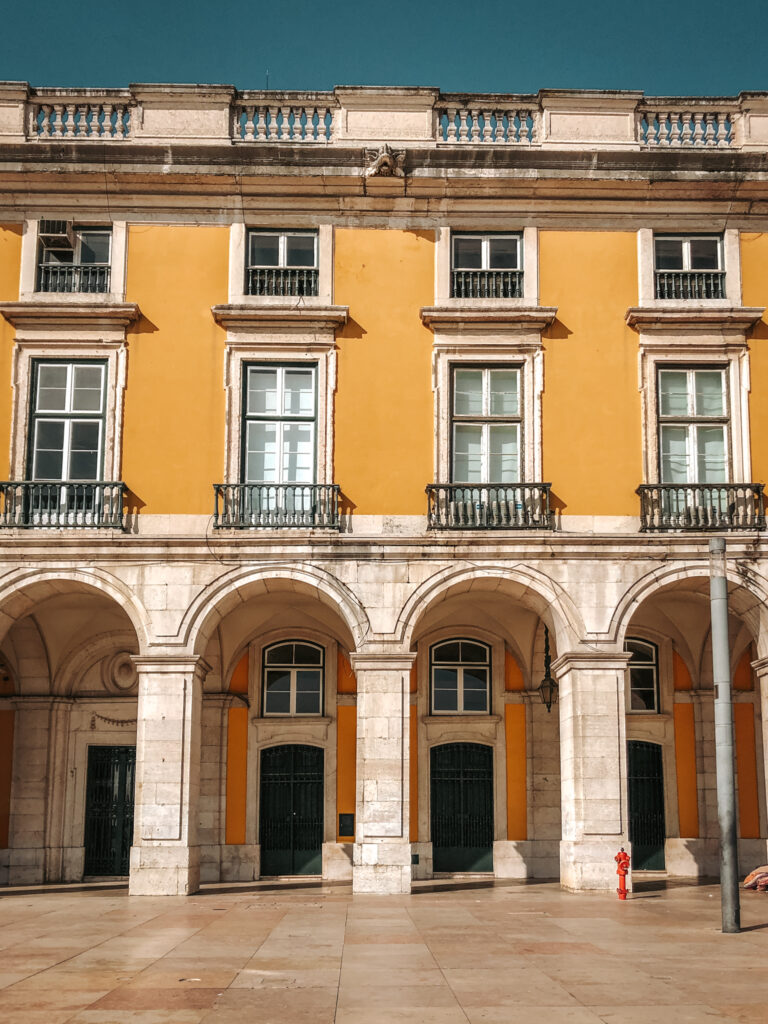
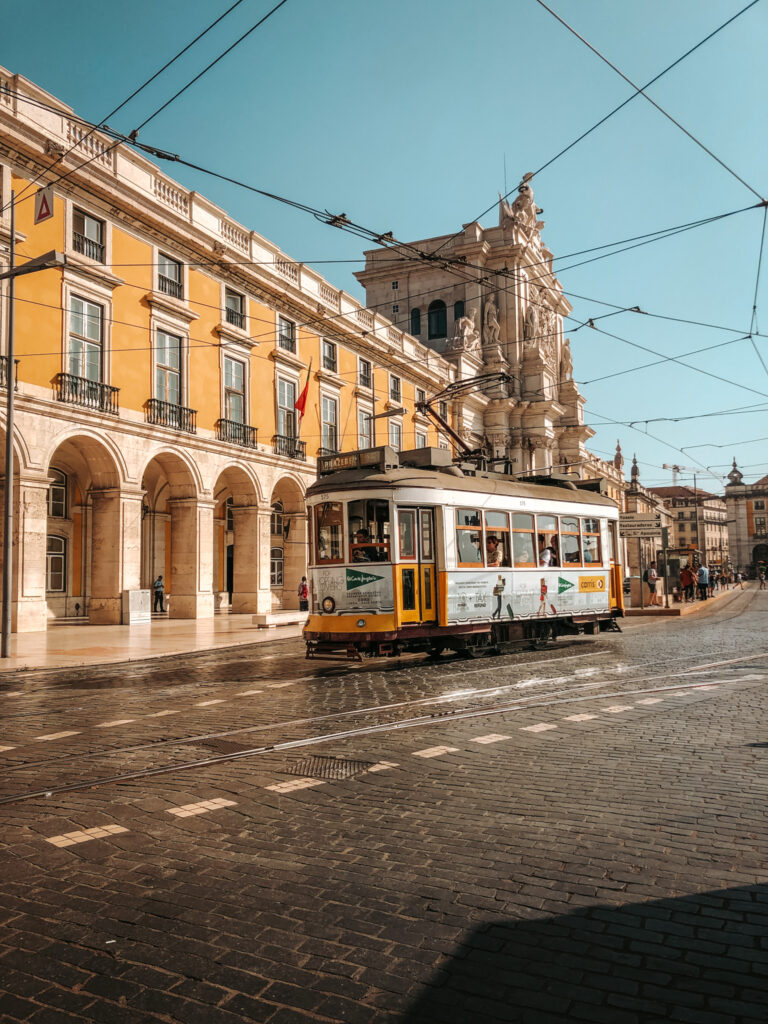
Here are some of the best things to see in Baxia:
Praça do Comércio | This is one of the highlights of Lisbon’s historical center and one of the most beautiful squares in Europe. It was once the home of the Royal Palace, but following the 1755 earthquake, it grew to represent a new era, where trade and the bourgeois class were favoured.
Arco da Rua Augusta | Praça do Comércio is also home of the famous Arco da Rua Augusta. Built in the late 19th century to commemorate the rebirth of the city after the earthquake, it is now possible to climb to the top to get a view of the Praça and the Baxia district (you can buy your tickets here)
Santa Justa Lift | Opened in 1899, this beautiful Neo-Gothic lift links the lower Baxia District to the upper Largo do Carmo Square. A return ticket costs €5,15 and includes the entrance fee to the viewpoint. The 24-hour transport ticket also includes access to the elevator but NOT the viewpoint and you will have to pay the €1,50 fee.
Travel Tip // This might be an unpopular opinion but I recommend you skip taking the Santa Justa Lift. Now I know that taking the lift might be tempting because honestly walking around Lisbon can be tiering. However, the lines are always extremely long for a quick and somewhat underwhelming ride (you can get the same one for free is you hike up to the upper part of the lift).
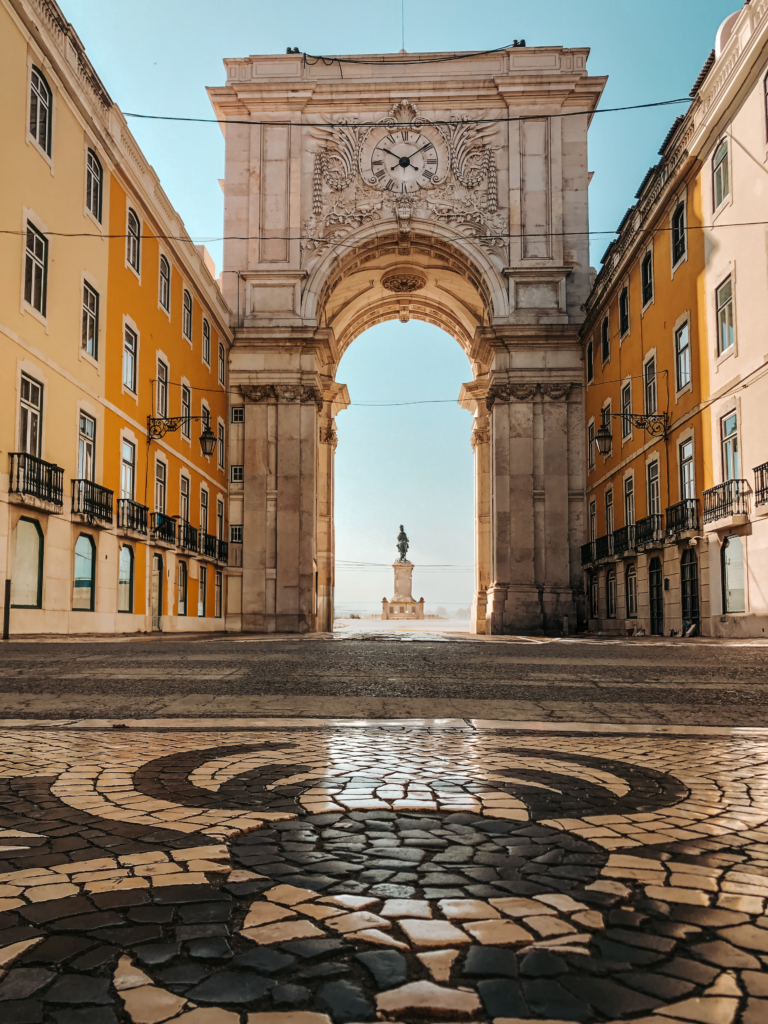
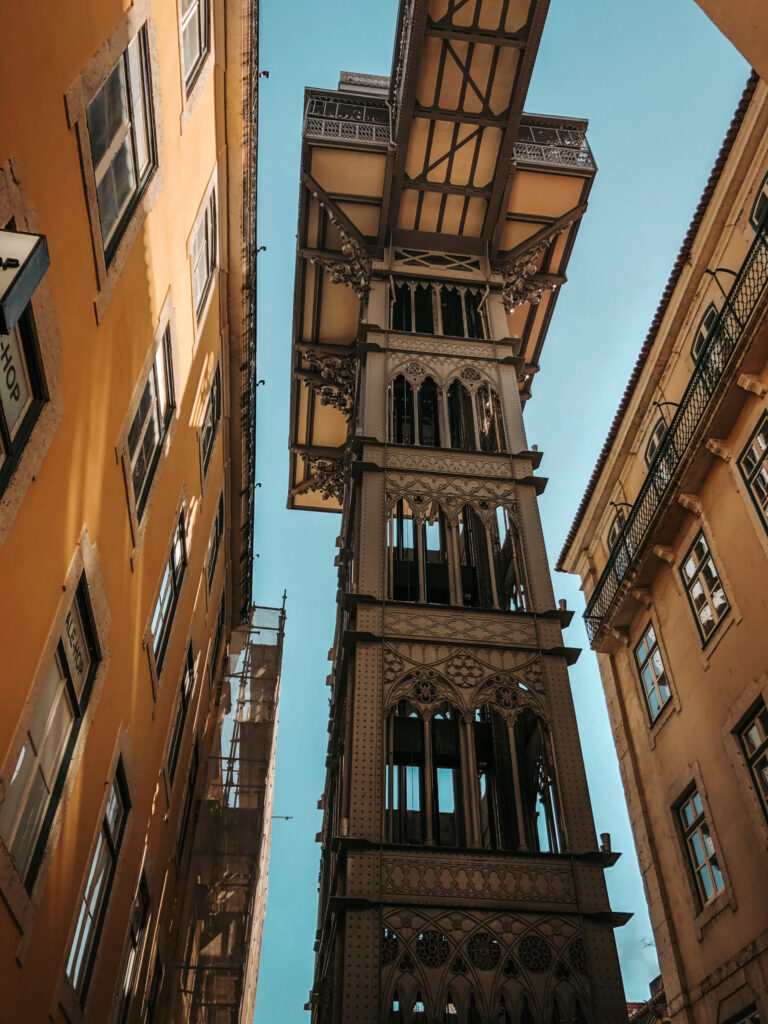
RIDE TRAM 28, LISBON’S SCENIC ROUTE
To ride, or not to ride, that is the question! Riding Tram 28 in Lisbon is one of the most iconic things to do in the City, but it can also be a flop if not done right. Did you know that it is estimated that Tram 28 transports around 4,5 million passenger every year? But get this… each tram can sit 20 people and about another 25 standing. If you do the math, that means very cramped cars.
The question is : is Tram 28 really worth the hype? The answer yes, but you need to do it right!
Trams 28 dates back to 1914 when horse drawn carriages were replaced by the now iconic yellow trams. If some lines use newer trams cars, Tram 28 looks very much the same as it at the beginning of the 20th century with wooden floors, timber window frames and yellow bodies.
But why is this route so popular? The 7km long route passes through the districts of Graça, Alfama, Baxia, Chiado, Santa Catarina and Estrela : basically all the popular districts of Lisbon. It takes about 50 minutes to travel the entire route between Largo do Martim Moniz and Campo Ourique.
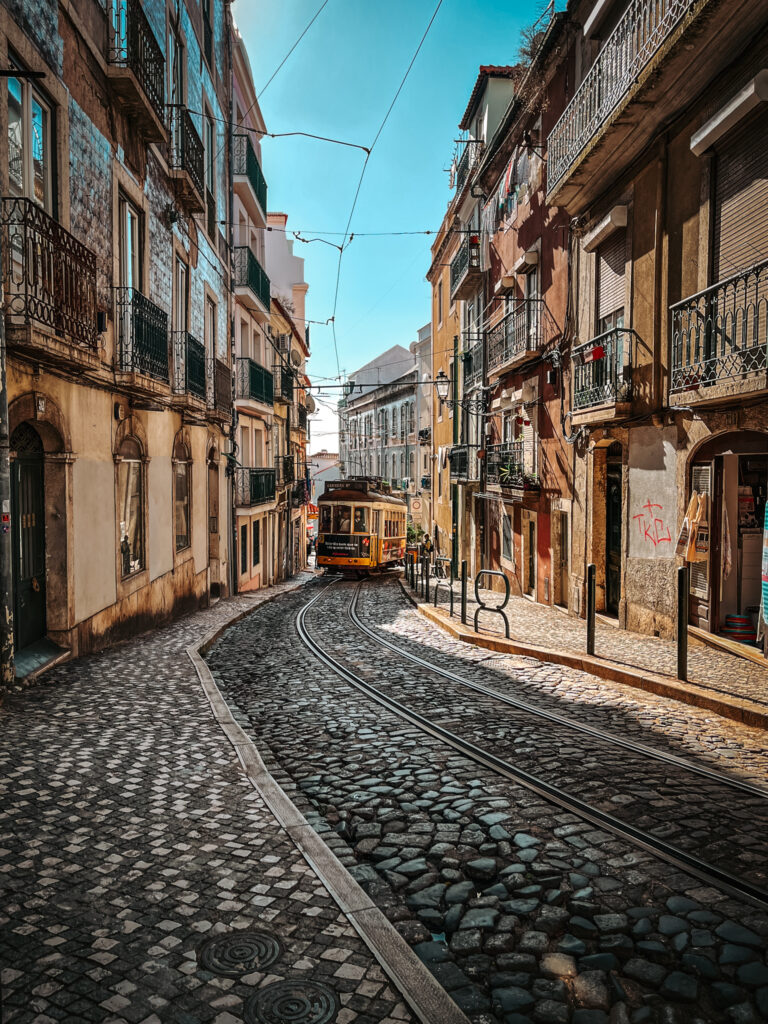
THE DETAILS
Where | There are multiple stops where you can hop on or off Tram 28 around the city. Find all the stops on this Google Map. Tram 28 runs about every 10 mins.
Price | It costs €3 one way. It is included in you daily metro pass or with the Lisbon Card.
Travel Tip // I recommend you start your journey at the Campo de Ourique stop, one of the terminal for the famous Tram 28. You’ll be able to get a seat next to the window and enjoy the entirety of the Tram 28.
Warning // Tram 28 is renowned for being a hotspot for pickpockets. Make sure you hold on to your belonging, especially if you are doing the ride standing.
Keep Reading // 5 tips for riding Tram 28 in Lisbon
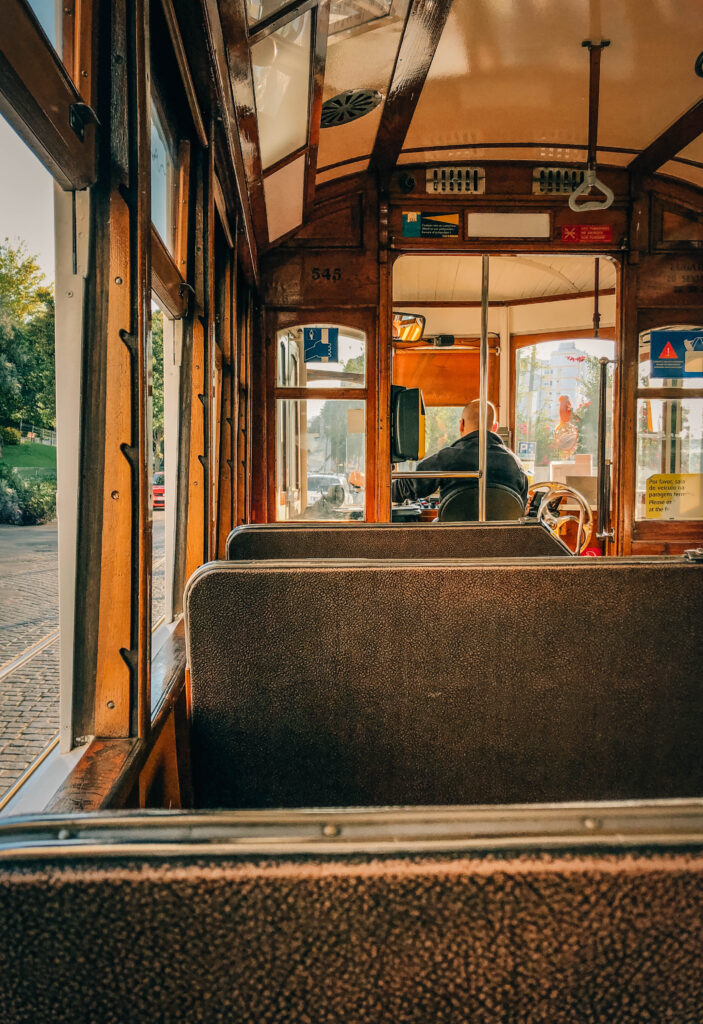
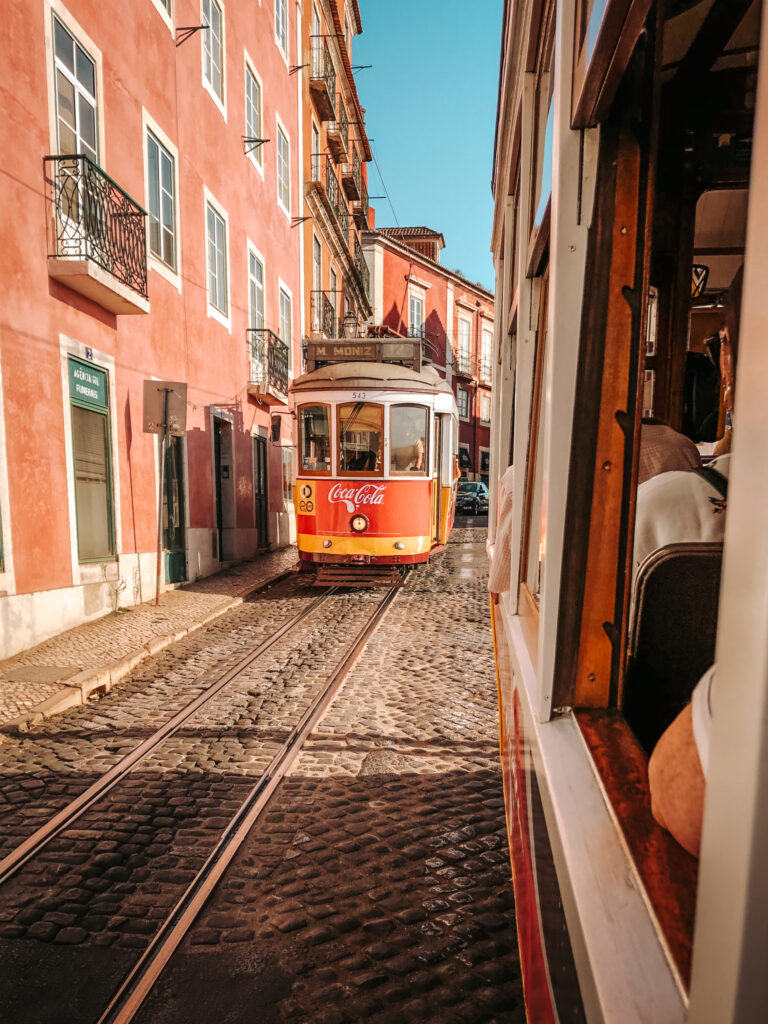
EXPLORE BAIRRO ALTO, THE MOST VIBRANT NEIGHBORHOOD
Translating to “Upper Neighborhood” in English, Bairro Alto sits on … the top of a hill. It is also the most recent of Lisbon’s old quarters. Built around 1513, it was the city’s first planned district outside of the medieval walls.
For a long time, this neighborhood was home to merchants and aristocrats. However, at the turn of the 18th century, it became known housing many newspaper offices. And with the journalists, came the bars…
Nowadays, the Bairro Alto is synonymous with amore bohemian lifestyle. If you want to enjoy the best nightlife in Lisbon, this is where you need to go. In the summer, street parties are a big thing here. Many bars will open their doors and bring the action to the small and narrow alleyways of Bairro Alto. See a list of the best nightlife spots in Bairro Alto here.
During the day, it is not as interesting as other neighborhood. However it is still worth a visit to see some of the city’s most iconic sites.
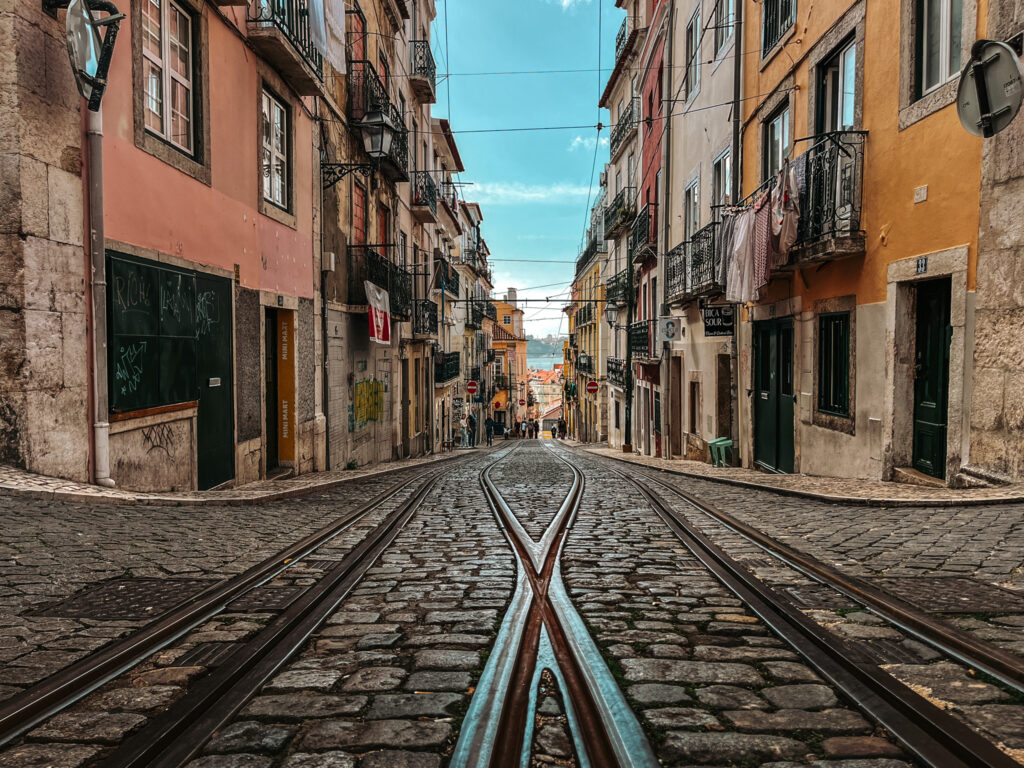
Here are some of the best things to see in Bairro Alto :
Ascensor da Bica | Built in 1892, this funicular is located on one of Lisbon’s steepest hills. With the same yellow body as the historical trams, it is one of the most photographed sites in Lisbon. Mostly used by tourists, this 23 passenger car leaves every 15 minutes until 9pm. The ride will cost you €3.80, and allow two trips on the same day. It is also included with the Lisbon Card.
Miradouro de São Pedro de Alcántara | Miradouro São Pedro de Alcântara is the perfect place to sit down and relax. You’ll get to enjoy amazing views on the São Jorge Castle.
Igreja de São Roque | Known as the “world’s most expensive chapel”, this church is definitely worth a look.
Travel Tip // You might have come across Lisbon’s Pink Street on social media. Let me break it to you : it does not look like Instagram. The two different times I visited it was dirty, the paint was peeling off and it was very crowded. If you find the right angle and know a thing or two about editing you might get that dreamy shot.
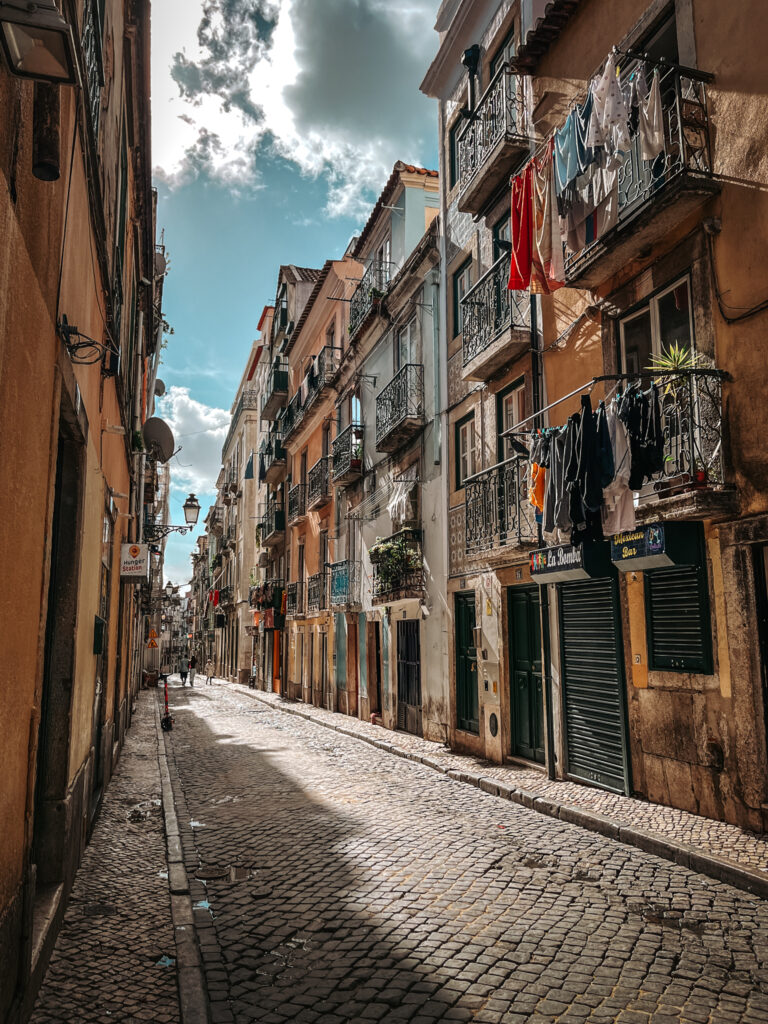
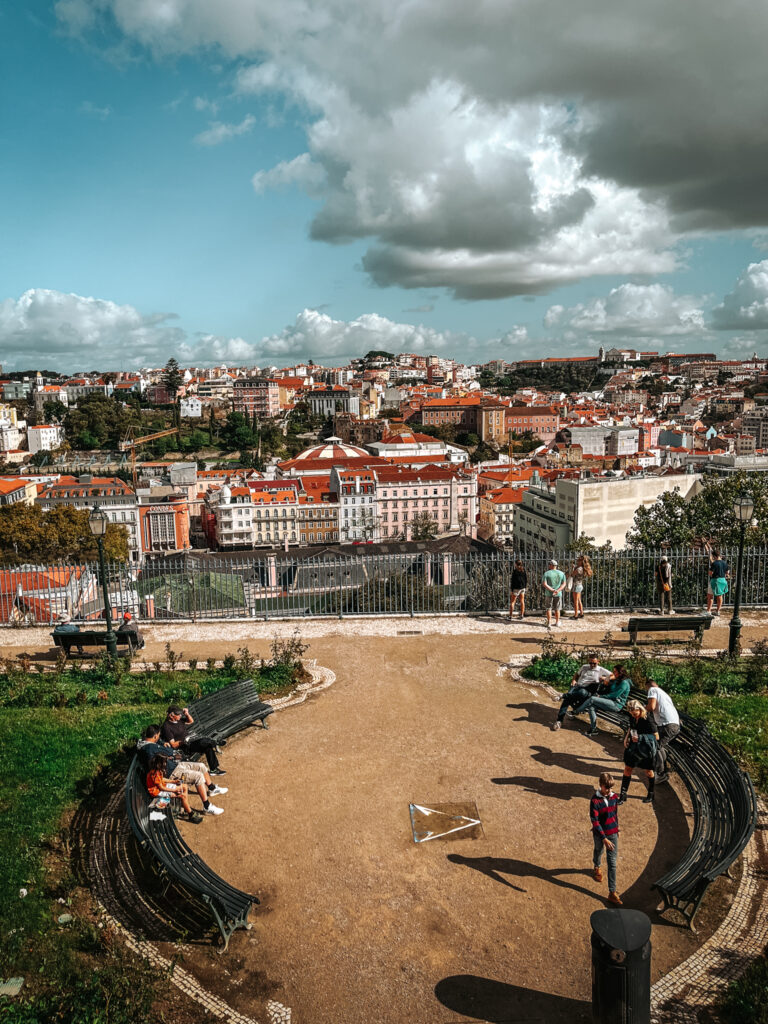
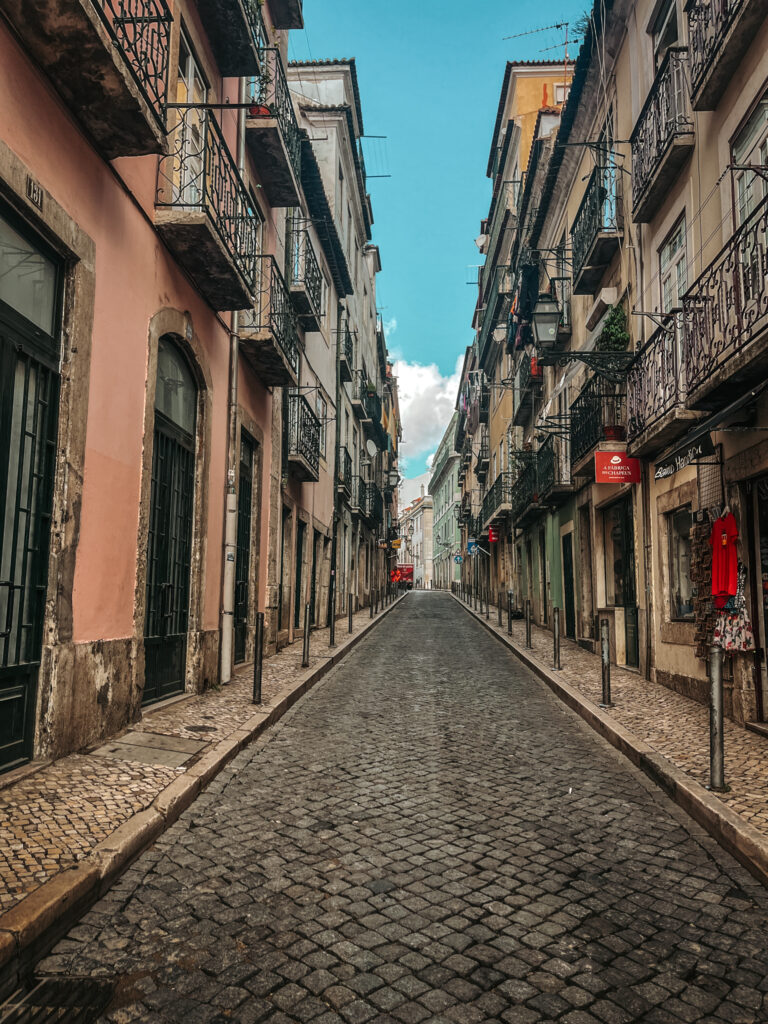
LISTEN TO FADO… AND GET ALL THE FEELS
Fado made me cry, it made me fall in love, it made me feel so many emotions all at once. It is not just music, it’s an experience.
Fado is described as music coming from “the Portuguese soul”. It tells the stories of heartbreaks, of love, of family, of history. It dates back to the mid-19th century. Often with only two guitars and a singer, fado recounts stories of everyday life, love and heartbreak.
Whether you are a music lover or not, going to a fado show is sure to leave you feeling something. And when it comes to fado, Lisbon has more than enough option to choose from. So much so that it can sometimes feel a bit overwhelming to know which to choose.
Where to listen to Fado?
Parreirinha de Alfama // For my first fado experience I choose Parreirinha de Aflama. They offer a fado show and dinner. In operation since 1950, it is described as one of Lisbon’s oldest Fado restaurants. It has been owned by the same family ever since. This is still, to this day, one of my favorite experiences in Lisbon.
For a cheaper option, this Fado show with Port wine is a good alternative with great reviews.
You can also choose this 3-hour Fado Walking Tour which includes live fado signing and a typical Portuguese meal.
Travel Tip // If you want to learn more about the history of fado, visit the Fado Museum.
VISIT THE JERÓNIMOS MONASTERY IN BELÉM
Located 6km to the West of the city center, Belém is one of the most visited Neighborhood in Lisbon. It has a long and fascinating history closely link with the Portuguese age of exploration.
Many Portuguese explorers actually left for the overseas voyages from the port of Belém. In 1497, Vasco da Gama actually spent an evening in the Jerónimos Monastery praying for a safe voyage. The next morning, he set sail with four ships and 150. His mission: find a route to Asia.
He succeeded by sailing around Africa and was the first European to reach Asia by sea routes. This opened the golden age of Portuguese exploration and Portugal became the richest nation in Europe.
Much like the Aflama district, Belém survived the 1755 earthquake with little to no damage. Which is why you will find some monuments that date back to this age of Portuguese exploration.
One of these is the majestic Jerónimos Monastery. Built in a Portuguese Gothic Manueline architectural style, this monastery is a feast for the eyes. The construction began in 1501 and took more than 100 to be completed. During the golden age of the Portuguese empire, it became the place where Portuguese royals were buried.
Today, it is a UNESCO World Heritage Site, and one of the most popular places to visit in Lisbon.
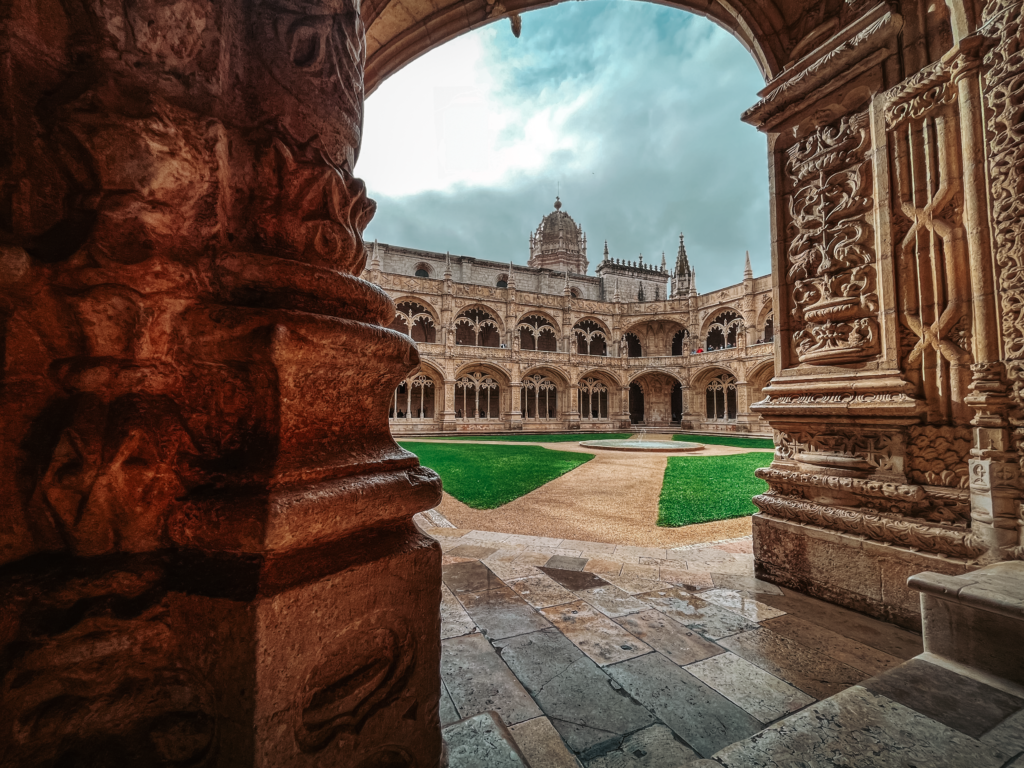
THE DETAILS
Where | The Jerónimos Monastery is located on the Praça do Império in Belém. Find the entrance here on Google Maps. It is also where you will find the ticket kiosk.
Price | Entry is €12 per person. You can purchase advance tickets here.
The entry is included in the Lisbon Card.
When | The Monastery is open every day of the week, expect for Mondays, from 10am to 5:30pm. It is closed on Mondays.
Keep Reading // How to Make the Best of Your Visit to Belém
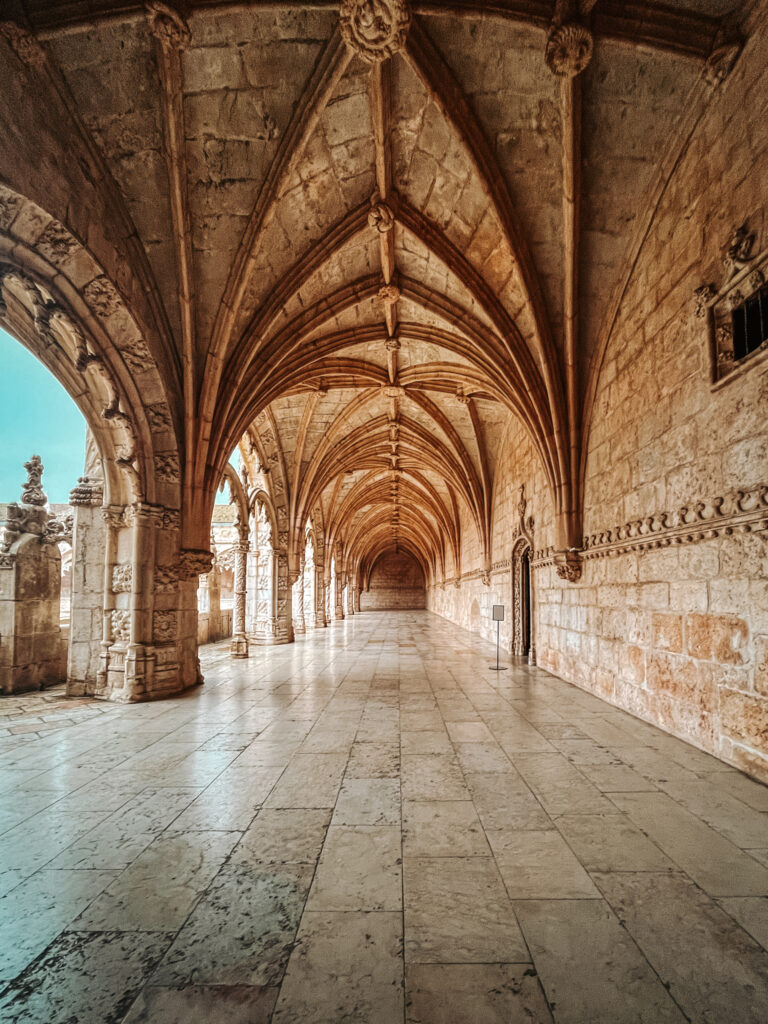
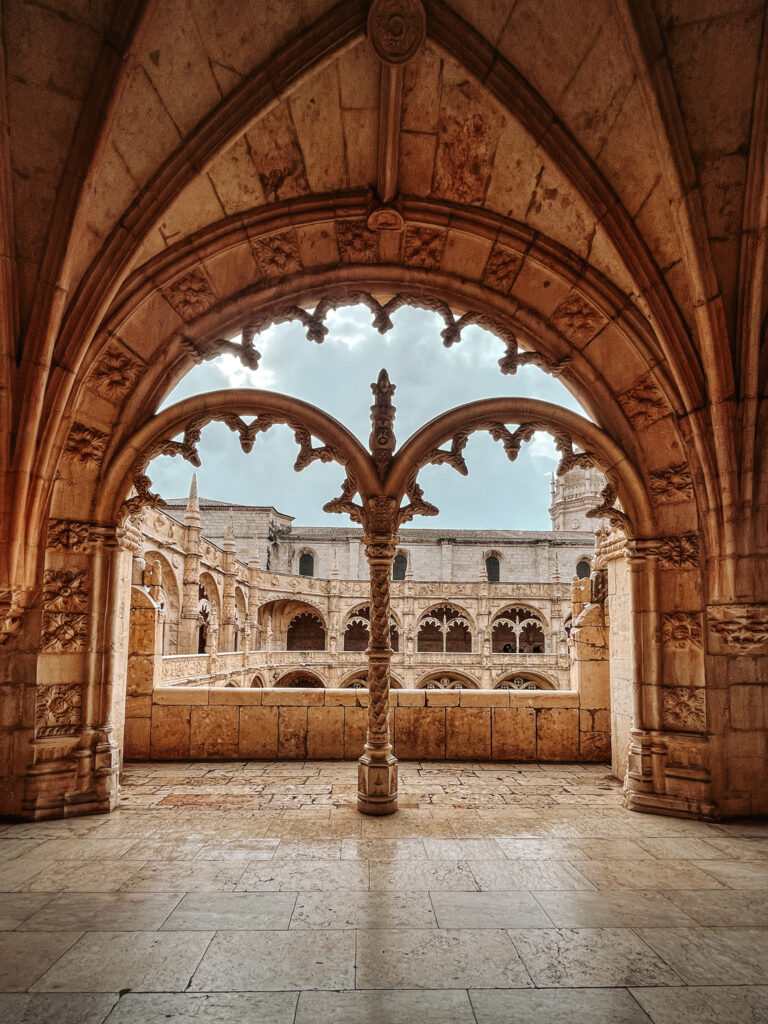
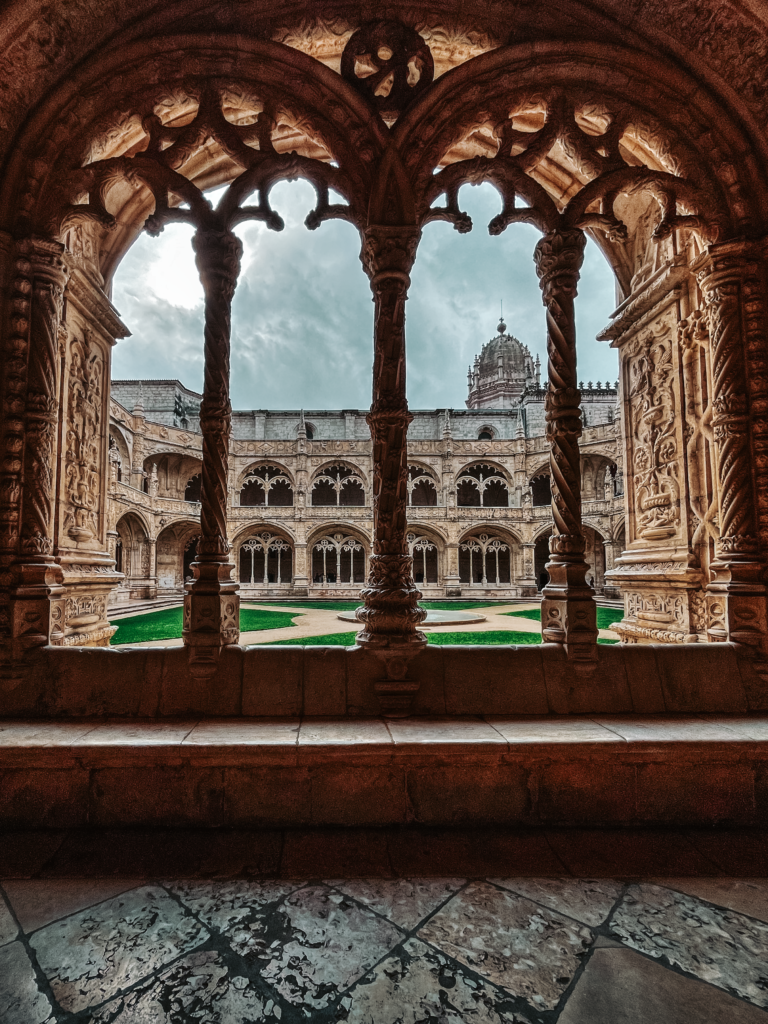
TRY SOME PASTÉIS DE NATA (OR PASTÉIS DE BELÉM)
You can’t visit Lisbon without trying some of the famous Pastéis de Nata, known in Belém as Pastéis de Belém. Despite what some will tell you, there is no difference between the Pastéis de Belém and the Pastéis de Nata. Historically, the Pastéis de Nata were invented in the Belém neighbourhood of Lisbon, hence their name when you visit Belém.
Here’s how the story goes:
The monks of the Jerónimos Monastery were the pioneers behind the creation and distribution of the famous custard tarts. The monks utilized egg whites for starching clothes and fabrics, they ended up with an abundance of leftover egg yolks. Rather than letting them go to waste, they ingeniously incorporated the yolks into their culinary creations, including cakes and pastries.
After the Liberal Revolution of 1820, the financial support for religious institutions in Portugal ceased, leading to their closure. In order to generate some income, the enterprising monks began selling their beloved custard tarts to the public. They decided to sell the custard tart recipe to a local sugar refinery. Recognizing the immense potential of this delectable treat, the refinery owners established the Fábrica de Pastéis de Belém in 1833.
But do the Pastéis de Belém live up to the hype? They are good yes, but definitely not the best Pastéis de Nata in Lisbon. And if you only taste these, you are missing out!
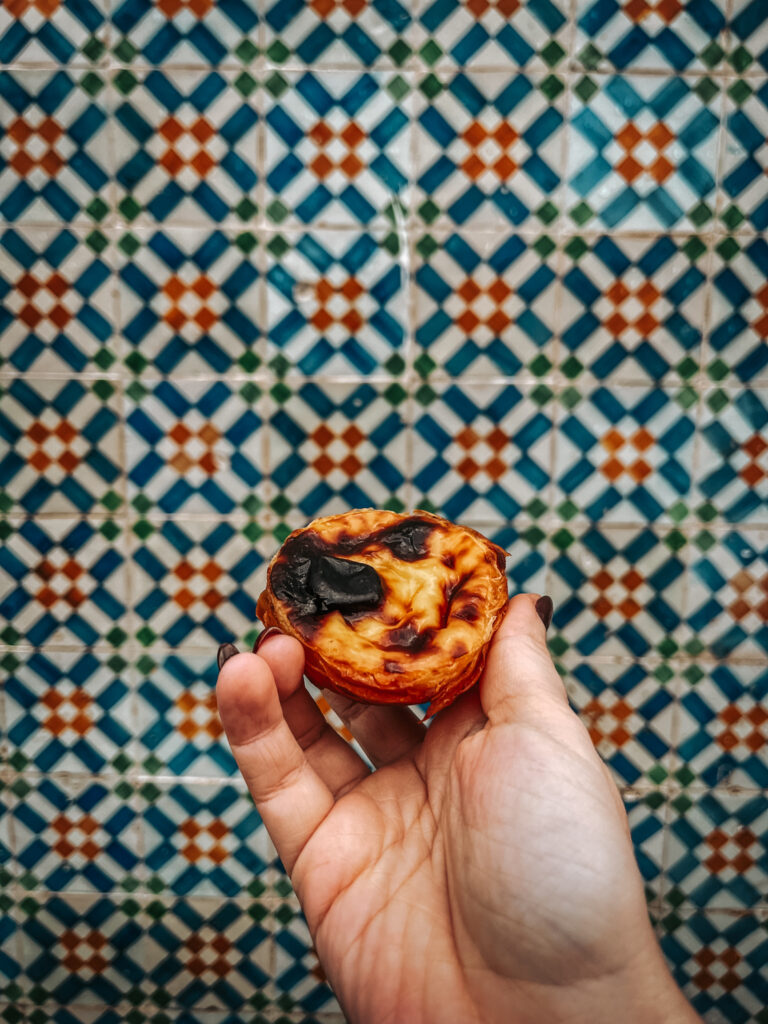
Here are some of the places to try Pastéis de Nata in Lisbon :
Pastéis de Belém | These are the OG pastéis de Nata so you have to try them at least once.
Travel Tip // Use the take out door instead of the one to sit in the restaurant. Go eat them in the park right in front of the bakery.
Pastelaria Alfama Doce | A cute little pastry shop in the Alfama District.
Manteigaria | If I had to choose a favorite, these would be it! They have many different address around Lisbon : I tried the ones at the Time Out Market.
Nata do LX | Located in LX Factory, these were also pretty yummy.
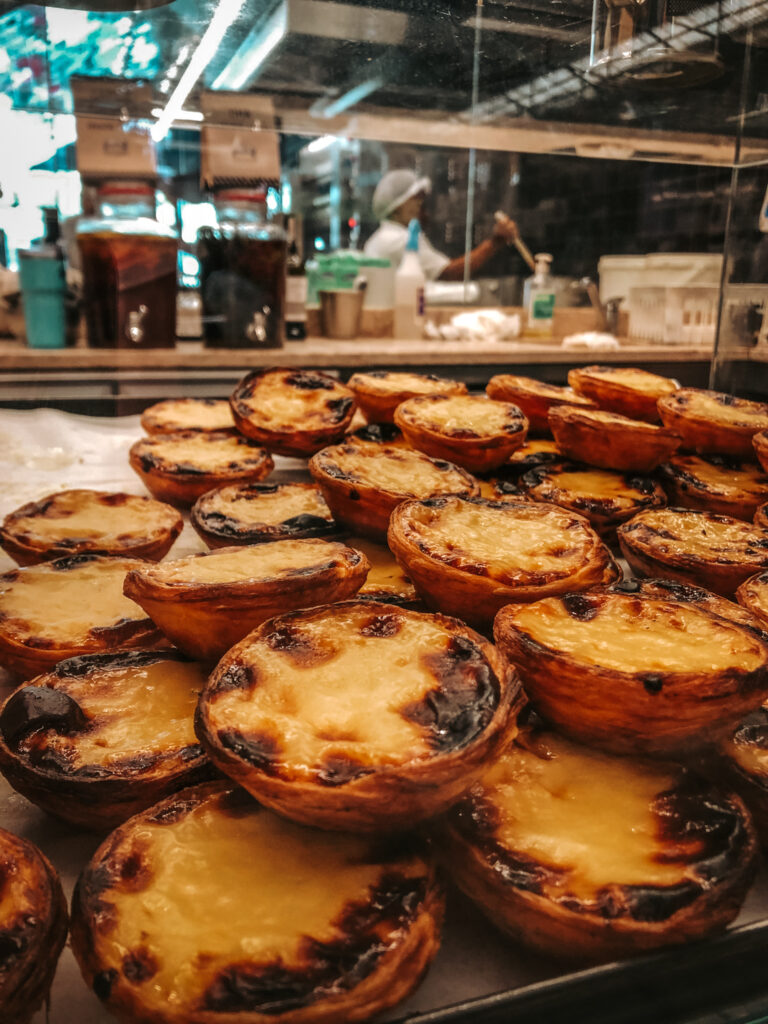
LEARN ABOUT THE PORTUGUESE AGE OF EXPLORATION AT THE MONUMENT OF THE DISCOVERIES AND THE BELÉM TOWER
By the early 16th century, Portugal had emerged as the dominant power in Europe. Through the control of trader routes to Asia, it had come to dominate the glodal trades of the time. The construction of the Belém Tower began in 1514. It was meant to showcase Portugal’s power and wealth and protect the city from potential invaders.
Constructed in the same Manueline style as the Jerónimos Monastery this tower is a true masterpiece.
In 1907, the Belém Tower was declared a National Monument. In 1983 it was designated a UNESCO World Heritage Site.
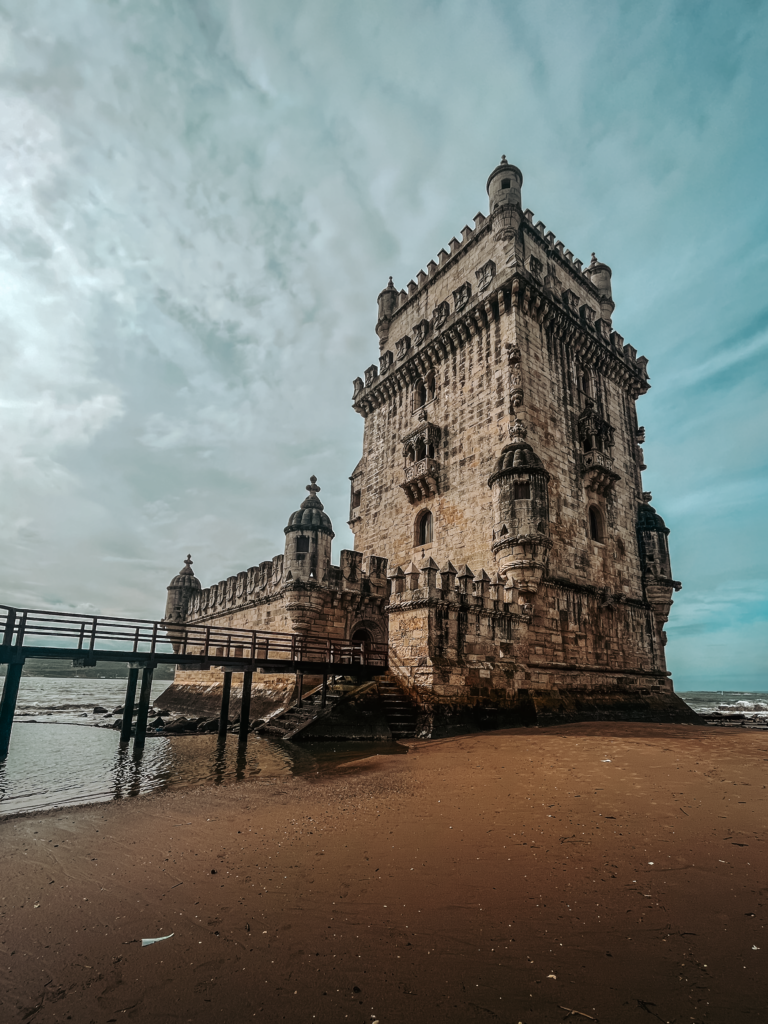
THE DETAILS
Where | The Belém Tower is located between the Belém Gardens and the Tagus River. Find it here on Google Maps.
Price | Entry is €8 per person. You can purchase advance tickets here.
The entry is included in the Lisbon Card.
Travel Tip // While you can visit the inside and climb the Tower, I don’t recommend it. On my first solo visit to Lisbon I waited in line a very long time to see the inside. I was quite disappointed. There is no furniture and the view is not particularly interesting. For that reason I would suggest you save some time and just admire the Tower from the outside. Try visiting at sunset the best photo opportunities.

Not far from the Belém Tower, you’ll find the Monument of Discoveries. This monument is an ode to the Portugal’s Age of Discoveries which lasted from the 15th to the 17th century. It was first built in 1940 in a temporary form as part of the Portuguese World Exhibition. In 1960 it was reconstructed to mark the 500 years of the death of Henry the Navigator. Henry the Navigator is the Portuguese Prince who financed most of the expeditions. He is often describe has the one who launched the European Age of Exploration.
Made to look like an exploration ship, the monument displays many men who played a key role in Portuguese exploration. At the head of the “ship” is Henry the Navigator.
THE DETAILS
Where | The Monument of Discoveries is located just a few minute walk from the Belém Tower. You can find it here on Google Maps.
Price | Entry is €10 per person. This includes an exhibition, a film and a lookout. You can purchase advance tickets here.
You get a 20% off discount with the Lisbon Card.
CHECK OUT THE HIP AND TRENDY LX FACTORY
In 1846, the Companhia de Fiação e Tecidos Lisbonense built its factory in Alcântara.
In the mid 2000s, a housing company decided to buy the factory. They transformed it into a hip and trendy district.
The contrast between medieval architecture of Belém and the more modern industrial architecture of LX Factory is quite striking. Loved my locals and tourist, this complex now houses more than 50 boutiques, art gallerias and restaurants. This is also the perfect place for street art lover.

THE DETAILS
Where | LX Factory is located about half-way between the city center and Belém. You can find it here on Google Maps.
Price | The entrance to LX Factory is free.
Some spots to check out while you are there :
- Nata do LX | Why not compare these Pastéis da Nata to those in Belém?
- Ler Devagar Bookstore | This instagram worthy Bookstore is definitely worth a visit.
- Cantina | Creative, homemade Portuguese Food
- LX Hostel | If you want to stay in LXFactory this hostel has some amazing reviews.
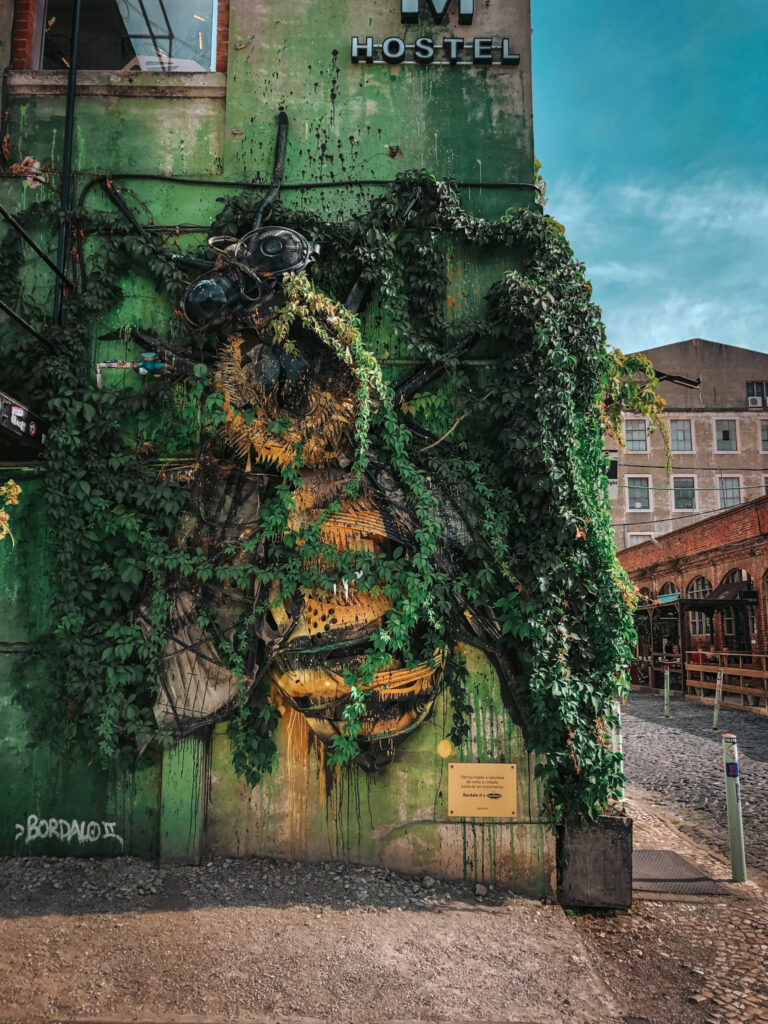
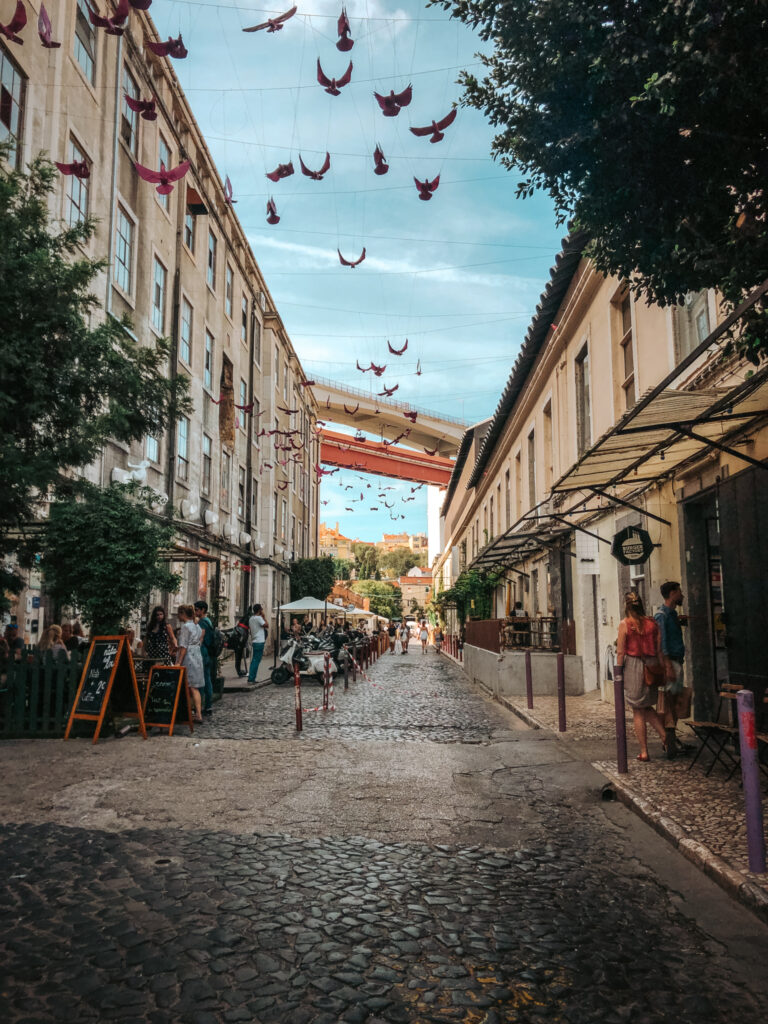

TAKE A DAY TRIP TO SINTRA AND SEE FAIRY TALE CASTLES
A visit to Sintra is the most popular day-trip from Lisbon, Portugal, and with reason. Sintra is a one of a kind magical town. Why you ask? Because in between it’s luscious green hill, Sintra hides some of the most beautiful castles and palaces in Europe. These castles are 40-minute from Lisbon, making it one of the best things to do in Lisbon.
In the 19th century, Sintra became a popular tourist destination among the Portuguese elite, including the king of Portugal himself. With its beautiful hills and luscious forest, Sintra was the perfect escape from the hustle and bustle of the city. Well-to-do Portuguese started to built their summer palaces in Sintra.
Today, most of the castles have been converted into museum for us to enjoy. The most notable is without a doubt the Pena Palace built in 1838 by King Ferdinand II. Other palaces are also worth a visit, including the Moorish Castle and Quinta da Regaleira.
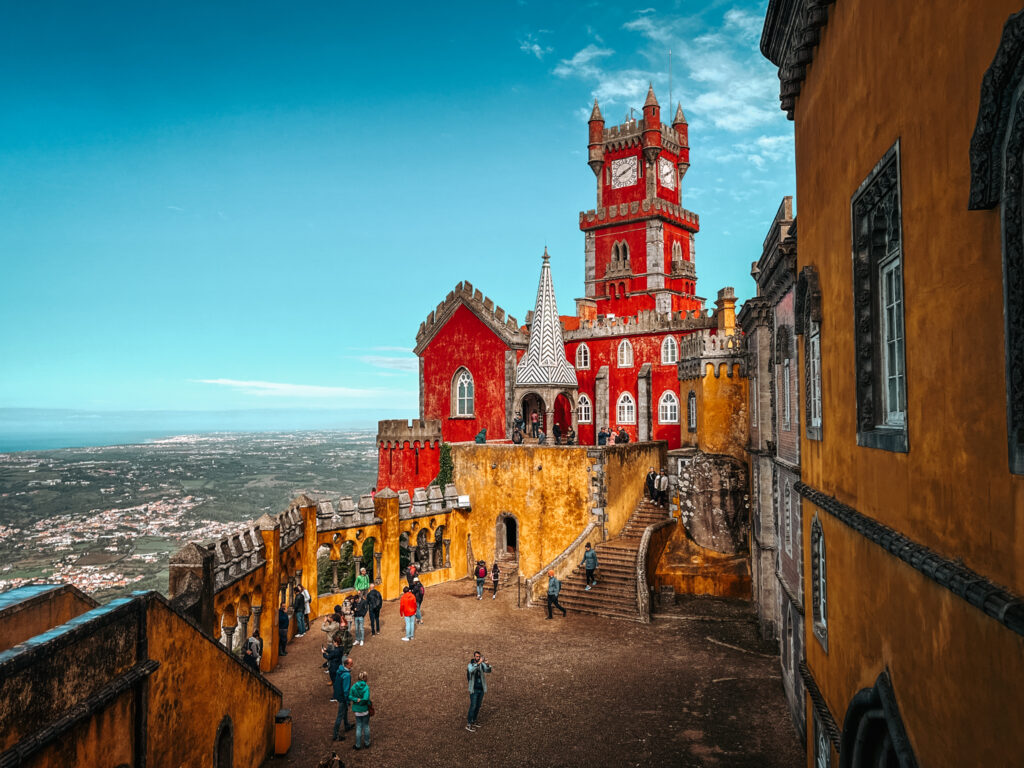
THE DETAILS
How to get there | Located 40 minutes from Lisbon, the town of Sintra is easily accessible by train. Here is how to get there:
- Take the metro (green line) to Rossio.
- Accross the street from the metro station you will find the Rossio Train station.
- Inside the station don’t forget to buy your train ticket to Sintra ( € 5 )
- There are multiple trains a day to Sintra but I recommend getting there early since the trains fill up quick.
Travel Tip // In one day, you can visit 2 to 3 castles comfortably. I recommend reserving your tickets before your visit. Found out how to make the most of your day in Sintra here.
Keep Reading // 1 day, 3 castles: How to make the best of your day in Sintra
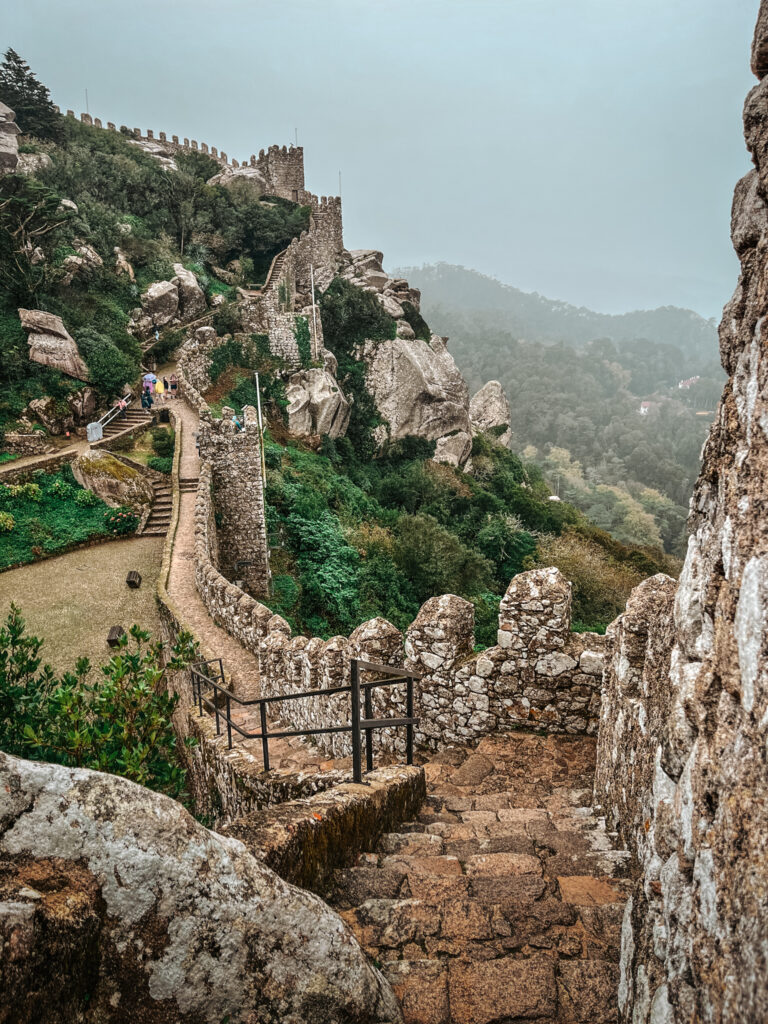
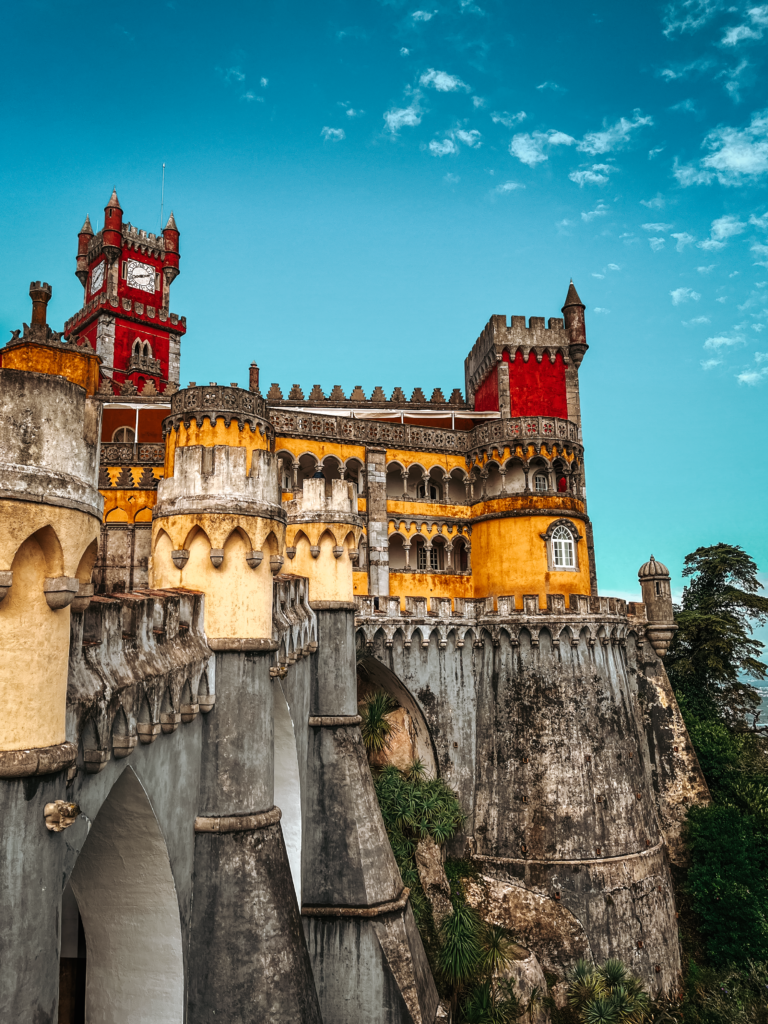
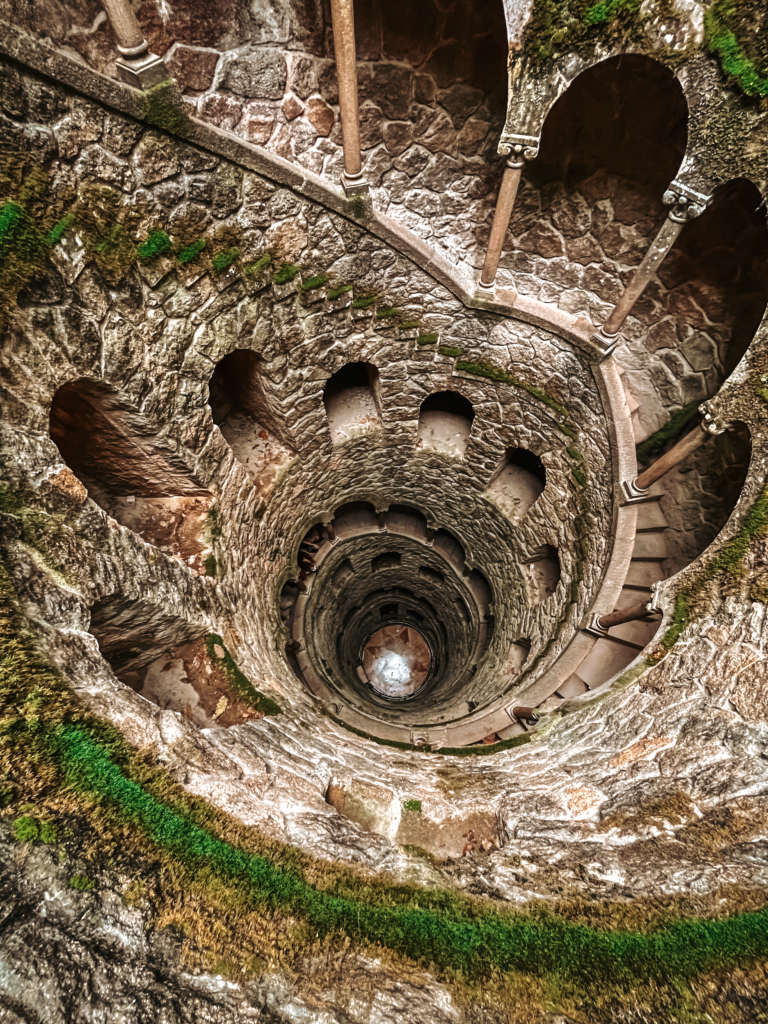
READ THESE POSTS BEFORE VISITING LISBON!
LISBON GUIDES | 14 Things to Know Before Visiting Lisbon; How to make the best of your visit to Belém; 1 day, 3 castles: How to make the best of your day in Sintra; 5 tips for riding Tram 28 in Lisbon; Where to Stay in Lisbon?
LISBON PHOTOS | 30 amazing photos of Lisbon
THE REST OF PORTUGAL | 11 amazing things to do in Porto; 9 amazing things to do in Lagos
PIN FOR LATER
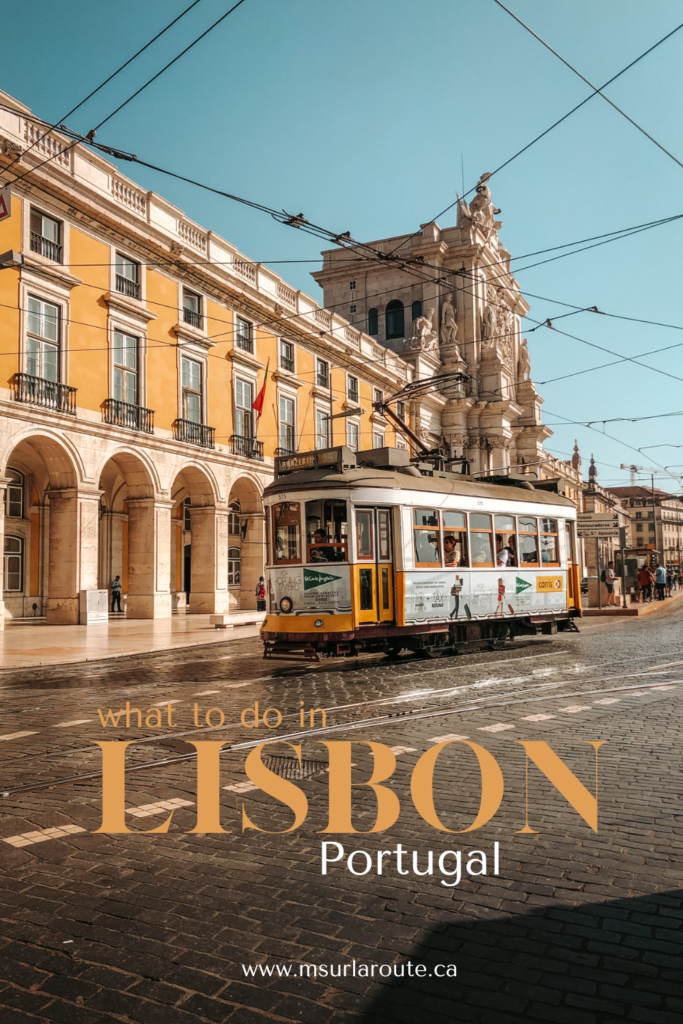


Follow me on Instagram!
Want to touch the southernmost point of mainland Canada? 👇🇨🇦
Then Point Pelee National Park needs to be on your summer list.
From epic sunsets and peaceful marsh boardwalks to migrating birds and butterflies, this park packs a lot into a small space.
In this quick guide:
📍 What to do
🗓️ Best time to visit
⛺ How to camp (hint: it involves oTENTiks)
🦋 And a few cool facts to impress your road trip buddy
Save this for later & tag someone who’d love to stand at the tip of Canada with you 🌊
🇫🇷 La version française de ce texte se trouve dans les commentaires.
#PointPeleeNationalPark #ExploreCanada #TravelOntario #ParksCanada #BucketListTrip #OntarioRoadTrip #NatureEscape #BirdingSeason #WanderOntario

Did you know Peterborough & the Trent-Severn Waterway made the New York Times list of 52 Places to Visit in 2025?
After a weekend exploring the area… I get it. Here’s what makes it one of Ontario’s best summer road trips ⬇️
🌿 Walk with alpacas at a local farm
🚤 Cruise through the world’s highest hydraulic lift lock
🍷 Sip sangria + eat wood-fired pizza at a vineyard
🛶 Visit the brand-new Canadian Canoe Museum
🌄 Hike through caves & forests at Warsaw Caves Conservation Area
🥧 Taste-test butter tarts in Hastings, Campbellford & Lakeside
The perfect Ontario getaway: nature, small towns, good food, and local gems everywhere you turn.
📍 Save this for your next summer road trip!
And tell me below — which stop are you adding to your bucket list?
🇫🇷 Saviez-vous que Peterborough et la voie navigable Trent-Severn figurent sur la liste des 52 destinations à visiter en 2025 selon le New York Times ?
Après un week-end à explorer la région… je comprends tellement pourquoi. Voici pourquoi c’est un road trip incontournable en Ontario cet été ⬇️
🌿 Marcher avec des alpagas dans une ferme locale
🚤 Naviguer sur la plus haute écluse hydraulique au monde
🍷 Boire de la sangria et déguster une pizza au feu de bois dans un vignoble
🛶 Visiter le Musée canadien du canot
🌄 Explorer les sentiers et les grottes du parc Warsaw Caves
🥧 Et bien sûr, faire le plein de tartes au beurre dans les charmants villages de Hastings, Campbellford et Lakeside
Le combo parfait : nature, petites villes, bouffe locale et histoire à chaque détour.
📍 Sauve ce guide pour ton prochain road trip d’été en Ontario !
Et dis-moi en commentaire : quelle activité te tente le plus ?
#discoveron
@ontariotravel and @kawarthas_northumberland
#PeterboroughOntario #TrentSevernWaterway #OntarioRoadTrip #ExploreOntario #SummerInOntario #HiddenGemsOntario #CanadianTravel

These Ontario spots understood the assignment… Saunas in the forest, hot tubs with a view, outdoor soaks under the stars, we’ve got it all!
Here are 6 places where the spa setup is reason enough to book the trip:
1. Aux Box (Huntsville)
2. The Baltic by Fort Tree House Co. (Minden)
3. Back Forty Glamping (Meaford)
4. Anupaya (Deep River)
5. Tiny Stays (Prince Edward County)
6. The June Motel (Beaver Valley)
Tag someone who owes you a spa weekend 💆♀️
🇫🇷 La version française de ce texte se trouve dans les commentaires
#OntarioStays #GlampingOntario #WeekendGetaway #SaunaVibes #HotTubGoals #OntarioSpas #TinyCabins #TravelOntario

I’m on a mission to put Belleville on the map for your Ontario summer adventures 🌞
This is way more than just a drive-by on the 401. Think: charming town vibes, scenic hikes, amazing food (I’m still dreaming about those perogies), and… turtles. 🐢
✨Here’s what I did (don’t forget to save the reel for the full breakdown!):
📍Explored downtown + coffee at Benji’s
🐢 Turtle Pond sanctuary
🥟 Lunch at Kafana (get the perogies!)
🌲 Hiked up Sager Tower (located in Quinte West just a short drive away)
🌮 Dinner at Pop-Ups on the Bay
🍓 Smoothies, wildlife, breweries & more on Day 2
🏖 Bonus: Presqu’ile for a beach day just 35 minutes away.
For this visit, I stayed at the Holiday Inn Express Belleville, perfectly located for all your Bay of Quinte adventures. 👌
Save this for your next summer roadtrip & tag someone who needs a mini escape!
🇫🇷 La version française de ce texte se trouve dans les commentaires
*made in partnership with Bay of Quinte Tourism*
#VisitBelleville #BayofQuinte #OntarioGetaways #HiddenGemsOntario #ExploreOntario #WeekendTripIdeas #MsurlarouteAdventures

Everyone visits Banff, but just an hour away, there’s also this. 👀
Grassi Lake in Kananaskis might just be one of the most underrated hikes in Alberta.
It’s short, it’s scenic, and the turquoise water? Totally unreal.
💦 Take the interpretive trail for waterfalls and forest views
⛰️ End at a lake so vibrant it looks photoshopped
So if you’re heading to the Rockies this summer, don’t sleep on Kananaskis.
Some of the best views are just off the radar.
💬 Been to Kananaskis or still on your list?
💾 Save this if you’re planning an Alberta trip!
🇫🇷 La version française est dans les commentaires! ⬇️
#GrassiLake #KananaskisCountry #AlbertaRoadTrip #HiddenGemsAlberta #ExploreKananaskis #HikingAlberta #BanffVsKananaskis #CanadianRockies #SummerInAlberta

